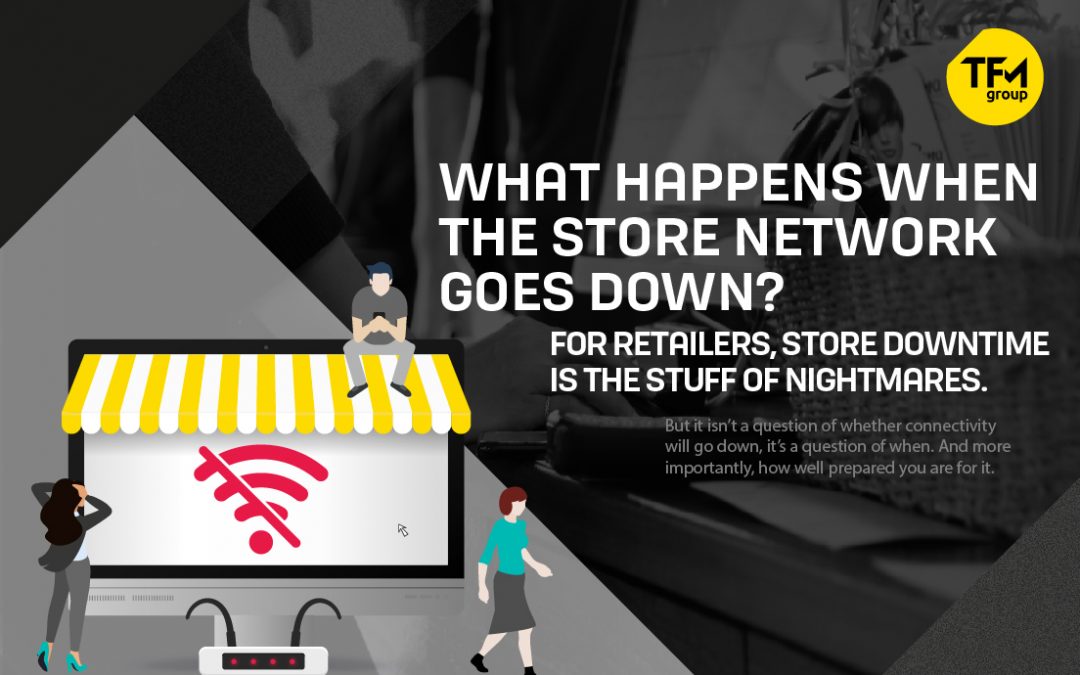For retailers, store downtime is the stuff of nightmares. But it isn’t a question of whether connectivity will go down, it’s a question of when. And more importantly, how well prepared you are for it.
Click and collect, digital screens for ads, videos and POP displays, automated tills and self check-out to reduce waiting times – today’s retailers live in a tech-fuelled world. Even if you’re not fusing clicks with bricks, your store will rely on broadband connectivity to power its Point of Sale systems and manage all the traffic for card and contactless payments.
So what happens when the technology goes down?
Running your shop infrastructure on a broadband product is fine when the broadband works. But downtime is more common than you might think. And most retailers don’t worry about a backup solution until it’s too late
The Uptime Challenge
In an ideal world, your store would have 100 percent fixed-line connectivity, 100 percent of the time. But the reality is, broadband largely has a consumer-level service specification. If you look at a lot of the SLAs around broadband, most guarantee around 99% – 99.5% uptime. This looks okay on paper, until you realise it equates to around 4 hours of potential downtime every single month.
And it may be 3 or 4 days before your connection is restored.
For retailers that rely on broadband, those are some pretty high stakes. How high? Well, for your typical retail store, network downtime can lead to a whole chain of negative events:
- POS become inoperable, so you can’t accept card payments
- Customers leave the store and shop elsewhere, meaning lost revenue
- Loss of customer goodwill – there’s a risk that frustrated customers will take their loyalty elsewhere after a bad experience
- Brand damage – a whopping 95 percent of consumers tell others about their negative experiences, and amplify that message across social media. Bad news travels fast, and the long-term reputational damage can often outweigh the immediate loss of revenue.
Lack of connectivity can also bring wider store operations like inventory management systems to a standstill. All of this results in escalating operational costs – and there’s a risk that fraudsters will find you an easy target during downtime.
The Crippling Cost of Downtime
What does all of this look like in money terms?
Back in 2014, US enterprise research and advisory consultancy Gartner set out to understand the true cost of connectivity outages, and the numbers they came up with are staggering – $5,600 per minute for the average business. Since there are so many differences in how businesses operate, downtime could be as much as $140,000 per hour at the low end, $540,000 per hour at the higher end and $300,000 per hour on average, Gartner suggested.
Here in the UK, research by Redcentric found that 40 percent of retailers would lose more than £10,000 if their store suffered an hour-long connectivity outage. Devastatingly, 17 per cent said an hour-long outage would cost up to £100,000.
Now consider that a broadband could occur at any time. How much more damage would there be if the network went down at the busiest time of the day, or the busiest day of the year? Could your business afford to lose £10,000 – £100,000 per hour if the broadband went down? What would be the cost if you lost connectivity on Super Saturday?
(Don’t answer. These are rhetorical questions.)
Securing Your Connection With a Wireless Failover
IT outages are the bane of any business but, for small, independent retail outlets, even a minor outage could potentially cause business death. If retailers don’t secure their connectivity, hundreds of thousands of pounds could be lost. It’s scary stuff.
Now for the good news (finally): 4G can keep your entire store portfolio online when the primary connection fails. We partner with market-leader Cradlepoint whose enterprise-grade wireless WAN routers automatically detect issues with the fixed line and seamlessly switch to 4G for instant failover. And there’s plenty of juice to ensure that your card-payment and POS systems stay operational at all times, no matter what your fixed line is doing (or not doing).
Most systems provide out-of-the-box connectivity meaning you install them yourself at the store. And they connect to the network with the best signal strength for the store’s location, so you can use them anywhere.
Now, outages are not always the fault of the broadband provider. One of the good things about 4G failovers is they provide rock-solid backup no matter what is causing your downtime. By some estimates, around 2 percent of outages are caused by IT personnel making changes to the core network, and a 4G system can seamlessly take over when there’s emergency maintenance to be done. It can also pick up the slack when there’s disruptive construction work in the vicinity, or a line-damaging blast of bad weather.
In fact, some of the bizarrest IT disasters in history could have been prevented with a 4G backup system. Did you know that an errant, cable-chewing squirrel took down Yahoo’s entire Santa Clara data centre operations in 2010?
Without a doubt, having a WAN continuity solution is critical to every retail business. And it’s so easy to get yourself protected. To learn more, call us for an exploratory chat today.


